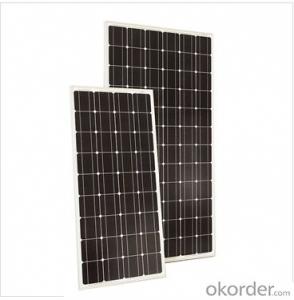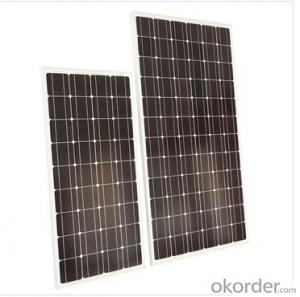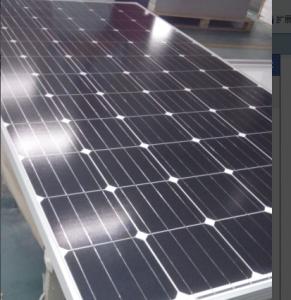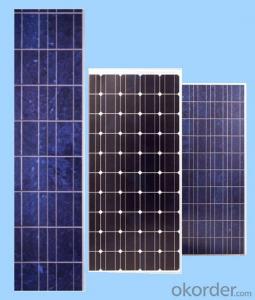Solar Monocrystalline Series Panels 300W
- Loading Port:
- Shanghai
- Payment Terms:
- TT OR LC
- Min Order Qty:
- 50 pc
- Supply Capability:
- 50000 pc/month
OKorder Service Pledge
OKorder Financial Service
You Might Also Like
Introduction of Solar Monocrystalline Series Panels
CNBM Solar photovoltaic (PV) Panel is designed for large electrical power requirements. It is the optimal choice for both on-grid and off-grid power systems. CNBM Solar panel offers high performance of power per square foot of solar array. Monocrystalline silicon(c-Si): often made using the Czochralski process. Single-crystal wafer cells tend to be expensive, and because they are cut from cylindrical ingots, do not completely cover a square solar cell module without a substantial waste of refined silicon. Hence most c-Si panels have uncovered gaps at the four corners of the cells.
Characteristics of Solar Monocrystalline Series Panels
I Solar Cell : High efficiency crystalline solar cell. Even if under the weak light, the solar module can produce maximum power output.
II Tempered glass (toughened glass): Anti-reflecting coating and high transmission rate glass increase the power output and mechanical strength of solar module.
III EVA and TPT: Using high quality EVA and TPT to prevent destroying and water.
IV AI frame: Without screw, corner connection. 6 holes on the frame can be installed easily.
V Junction box: Multi function junction box with water proof.
VI Long lifetime: ≥25 years; Less power decrease
VII Good performance of preventing from atrocious weather such as wind and hails.
VIII Resisting moisture and etching effectively, not effected by geology.
Standard Test Conditions of Solar Monocrystalline Series Panels
The opto-electrical specifications shown below are stabilized values being measured at Standard Test Conditions, Irradiance: 1000W/m2, Spectrum: AM1.5 at 25°C, The info below is subject to manufacturing tolerances. Where appropriate minutes of measurement are available and are used for the dimensioning of the installation.
Advantages of Solar Monocrystalline Series Panels
• CNBM Solar performance guarantees for 25 years
• 12 years guarantee for workmanship
• Timeliness of delivery
CNBM International Corporation's products including Monocrystalline Solar Panel, Polycrystalline Solar Panel have received and enjoyed famous reputation in many countries and regions in the world .As a solar panel supplier in China, we strive to provide our customers with excellent service, superior products and unmatched value.
Model Number | 300W |
Material | Monocrystalline Silicon |
Size | 1956*992*50mm |
Max. Power | 300w |
Frame | Double-layer anodized aluminium alloy |
Weight | 25Kg |
Surface maximum load capacity | less than 5400pa |
Front cover | 3.2mm thick, tempered glass |
Back cover | TPT(Tedlar-PET-Tedlar) |
Encapsulant | EVA(ethylene-vinyl-acetate) |
Maximum power at STC (Pmax) | 300Wp |
Maximum power voltage (Vmp) | 36.7 |
Maximum power current (Imp) | 8.17 |
Open circuit voltage (Voc) | 45 |
Short circuit current (Isc) | 8.63 |
Junction Box | IP65 RATED |
Cables/connectors | 4.0mm² 900mm/MC4 or compatible connecors |
Application Class | Class A |
Maximum system voltage | DC1000V (IEC) |
Maximum series fuse | 15A |
Operating Temperature | -40℃-85℃ |
Storage temperature | -40℃-85℃ |
Moudule Area(m²) | 1.94 |
Packing configuration | 300pcs/20ft container, 624pcs/40ft container |
FAQ
We have organized several common questions for our clients,may help you sincerely:
1. What’s price per watt?
A: It’s depends on the quantity, delivery date and payment terms of the order. We can talk further about the detail price issue. Our products is high quality with lower price level.
2.Can you tell me the parameter of your solar panels?
We have different series of cells with different power output, both from c-si to a-si. Please take our specification sheet for your reference.
3.How do you pack your products?
We have rich experience on how to pack the panels to make sure the safety on shipment when it arrives at the destination.
4.Can you do OEM for us?
Yes, we can.
5. How long can we receive the product after purchase?
In the purchase of product within three working days, We will arrange the factory delivery as soon as possible. The perfect time of receiving is related to the state and position of customers. Commonly 7 to 10 working days can be served.
- Q:I'm thinking of getting a solar panel for my house to help cut back on power use (I live in New Mexico). What sort of appliances can I run on a watt solar panel? Is it worth it to get a single watt panel or is it more efficient to get a multi-watt panel?
- You can run a lot of things. If you set the system to charge batteries when you are not using anything, they will charge effectively. You can use the system for lighting, LED lighting direct from the battery power is most effient since LEDs are low voltage devices with a very long life span. I replaced a 2 tube flourescent trough with four 5Watt PowerLEDs for example, While I have it on 20VAC at the moment, I can move it to 2 VDC power with ease, and had set it up to run initially on 2 volt sources. There are also many 2 volt appliances as well. You can even convert some of those all in one stereo systems to operate on 2 volts by eliminating the power supply. You will actually use less power by doing so. You will not be able to blow the shingles off the roof unless you add a Class D amplifier to the output, but for most listening, the output is adequate. Some small TV's these days can be run from 2 volt sources, if not directly, then with a buckboost inverter for a laptop. The small TVs only draw about 30 to 45 Watts. Skip the idea of using an inverter, they are not efficient at small loads, and represent additional load on the system. So with a little bit of planning, you can run a lot from that 60 Watt system. You can at least take some bite out of the electric bill for mundane lighting. You can also use them to keep power up on a battery system for lighting in a remote barn. The uses are only limited by your imagination and creativity.
- Q:cheapest price for a 20 watt solar panel sold on line
- Solar panels installed are roughly $0/watt in commercial quantities. Bare panels? Do a google search and see what you can find. But for the record, there are panels and there are panels. Stuff from China put together in a shed somewhere will not perform in the same way as some of the new thin-film amorphous panels coming out of the US and Europe. So, in many ways you get exactly what you pay for.
- Q:How much energy can be generated from a solar panel on a clear, bright summer's day for example?
- Well, the maximum amount of energy you can receive with 00 percent efficiency is kilowatt per square meter. This is the energy that hits the Earth's surface. The best commercially available panels are 20-30 percent efficient. Cutting edge technology has gotten this percentage up to 50 percent, but you can't buy these for your home. If you're curious about efficiency, check out a panel's dimensions, find the area in square meters, and use that along with its Watts (divide by 000 to get kilowatts) to get your answer.
- Q:Can solar panels be used for satellite communication?
- Yes, solar panels can be used for satellite communication. Solar panels are often used to power satellites as they can convert sunlight into electricity. This generated electricity can then be used to operate various communication systems and equipment on board the satellite, enabling satellite communication.
- Q:How do solar panels affect the overall resilience of a building?
- Solar panels can significantly enhance the overall resilience of a building. By harnessing renewable energy from the sun, solar panels provide a reliable and sustainable source of electricity, reducing the dependency on traditional power grids. This independence ensures that essential services, such as lighting, heating, and cooling, can still function during power outages. Additionally, solar panels contribute to energy savings, reducing long-term operational costs and making a building more financially resilient. Moreover, solar panels reduce carbon emissions, mitigating the impact of climate change and enhancing the building's resilience to environmental challenges.
- Q:How many solar panels would it take to run an electric motor the needs 480 volts and pulls about 45 to 50 amps?
- If you have 480 volts, it might be 3-phase, and not a simple matter of multiplying volts and amps. However, that's in the ballpark of 25 kW, very doable for solar. That's on the high end of a residential installation, but very small for an institutional installation. What will influence the size of the array more is where you are geographically (that is, how much sun you get), and how often the motor runs (that is, how much energy in kWh does it use per day)? 480 volts is nothing to be trifled with. You should really get a power engineer to architect your system.
- Q:What is the difference between on-grid and off-grid solar systems?
- On-grid solar systems are connected to the local electricity grid, allowing excess electricity to be fed back into the grid and potentially earn credits or payments. Off-grid solar systems, on the other hand, are not connected to the grid and rely on energy storage solutions, such as batteries, to provide electricity when solar production is low or during nighttime.
- Q:I am writing some mock legislation for a school club and I need to know some of the environmental effects of solar panels. Also, where can I find specific studies(like from colleges and/or universities) proving these benefits as well as benefits and reasons of going green.
- Hi there, as a great starting point take a look here okorder Should give you most of what you require
- Q:How do solar panels affect the overall air quality of a building?
- Solar panels have a positive impact on the overall air quality of a building. They generate electricity by harnessing solar energy, which is a clean and renewable source. By using solar panels, buildings can reduce their dependence on fossil fuel-based power sources, such as coal or natural gas, which produce harmful emissions. This reduction in greenhouse gas emissions helps to improve the air quality, making the building more environmentally friendly and sustainable.
- Q:Hi everyone, I am a novice in solar energy system. I want to know if I am on the right track. Recently I bought a 30 W solar panel, 5 Amp controller, and a 22 Ah battery, how many watts and what kind of INVERTER do I need? I did an research some said 50 W and some said 300 W. And am I right on the 5 amp controller and 22 Ah battery to provide larger output of electric, or the higher the # the greater output for 30 W solar panel?Really appreciate for anyone who help!!!
- With a 30 watt panel, producing about 2 amps, your not going to have much power from that. A 22 AH battery will give you 2 AH of usage. A battery should never be drained below 50%. What this works out to be is simply Amp draw for 2 hours. Which equals to 2V light bulb that draws amp for 2 hours. Not much. Now to replace that usage with your 30 watt panel, provided the panel is clean and in max sunlight, it will take 6 hours. If you attach an inverter to your system for 5 Volt Usage then the DC voltage drawn from the battery is very high. Example: Say you use a 5 Volt component that requires 50 Watts per hour to operate. The inverter will draw 5 Amps out of the Battery every hour to operate that component. That gives you and /2 of use before the battery is down to 50%.. Maybe that will be enough to charge up a standard Laptop battery. I have 2 30 Watt panels that produce 5 Amps, 4 6V batteries that have 480 AH and a 25 Amp Controller with a booster that increase the amp output to 20 Amps per hour. I live full time in an RV and raise the panels to get max output when I am parked. This system provides me with all the 5V throught the 500 Watt inverter that I need. Good luck on you system.
1. Manufacturer Overview |
|
|---|---|
| Location | |
| Year Established | |
| Annual Output Value | |
| Main Markets | |
| Company Certifications | |
2. Manufacturer Certificates |
|
|---|---|
| a) Certification Name | |
| Range | |
| Reference | |
| Validity Period | |
3. Manufacturer Capability |
|
|---|---|
| a)Trade Capacity | |
| Nearest Port | |
| Export Percentage | |
| No.of Employees in Trade Department | |
| Language Spoken: | |
| b)Factory Information | |
| Factory Size: | |
| No. of Production Lines | |
| Contract Manufacturing | |
| Product Price Range | |
Send your message to us
Solar Monocrystalline Series Panels 300W
- Loading Port:
- Shanghai
- Payment Terms:
- TT OR LC
- Min Order Qty:
- 50 pc
- Supply Capability:
- 50000 pc/month
OKorder Service Pledge
OKorder Financial Service
Similar products
New products
Hot products
Hot Searches
Related keywords






























